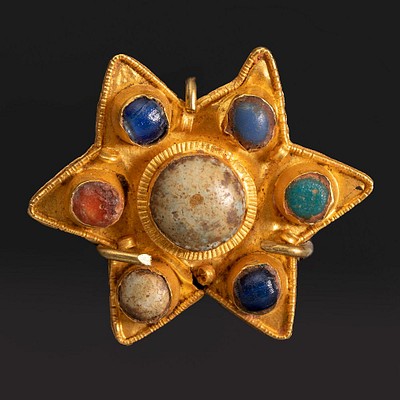ANTONIO DEL CASTILLO Y SAAVEDRA (Cordoba, 1616 - 1668). "Gentleman playing the trumpet". Reed pen, brown and black ink on laid paper.
Lot 78
About Seller
Setdart Auction House
Carrer Aragó 346
Barcelona
Spain
Setdart Subastas was born in 2004 and is currently the first online art auction in Spain with solidity, prestige and reliability guaranteed by our more than 60,000 users. Setdart has a young, dynamic and enterprising team ready to successfully manage the purchase and sale of art works through custom...Read more
Categories
Estimate:
EUR€8,000 - EUR€9,000
$8,333.33 - $9,375
Absentee vs Live bid
Two ways to bid:
- Leave a max absentee bid and the platform will bid on your behalf up to your maximum bid during the live auction.
- Bid live during the auction and your bids will be submitted real-time to the auctioneer.
Bid Increments
| Price | Bid Increment |
|---|---|
| EUR€0 | EUR€10 |
| EUR€200 | EUR€25 |
| EUR€500 | EUR€50 |
| EUR€1,000 | EUR€100 |
| EUR€3,000 | EUR€200 |
| EUR€5,000 | EUR€500 |
| EUR€10,000 | EUR€1,000 |
| EUR€20,000 | EUR€2,000 |
| EUR€50,000 | EUR€5,000 |
About Auction
By Setdart Auction House
Dec 21, 2021
Set Reminder
2021-12-21 07:30:00
2021-12-21 07:30:00
America/New_York
Bidsquare
Bidsquare : Córdoba: 2,000 Years of Art
https://www.bidsquare.com/auctions/setdart-auction-house/c-rdoba-2-000-years-of-art-8049
Setdart Auction House sofia@setdart.com
Setdart Auction House sofia@setdart.com
- Lot Description
ANTONIO DEL CASTILLO Y SAAVEDRA (Cordoba, 1616 - 1668). "Gentleman playing the trumpet". Reed pen, brown and black ink on laid paper. Work registered in: Navarrete Prieto, Benito & Garcia de la Torre, Fuensanta, Antonio del Castillo (1616-1668) Drawings. Catalog Raisonné, Marcelino Botin Foundation, 2008. Presents inscription "Castillo", located in the lower left margin. Provenance: Stirling-Maxwell Collection, Keir. Measurements: 14.5 x 10 cm; 37.5 x 28.5 cm (frame). In this work the author presents a drawing of a man playing the trumpet, in whose background can be appreciated what looks like a flag waved by the wind. It is worth mentioning the great draftsmanship of Antonio del Castillo, which was praised by Palomino, who mentioned the great mastery of the author, in addition to reflecting a great abundance in his work as a draftsman. In the article that talks about the painter, written by Benito Navarrete also makes a special mention to Castillo's work as a draftsman; "He is the most important draftsman of the Spanish Golden Age for his versatility, inventiveness and quantity of preserved drawings, in addition to the sustained quality of them". Antonio del Castillo y Saavedra was the son of an Extremaduran painter from Llerena, Agustín del Castillo, whose work is little known, but whom Palomino describes as "an excellent painter". He was orphaned in 1626 and was educated by another painter of whom we have no news, Ignacio Aedo Calderón. At an unknown date he may have arrived in Seville -of which there is no effective proof-, where Palomino makes him a pupil of Zurbarán, which has been corroborated in view of the stylistic influence of the master from Extremadura in Castillo's work. In 1635 he was in Cordoba, where he married and settled permanently, becoming without discussion the most important artist of the city. There he produced religious altarpieces as well as portraits and medium-sized series. His work does not show any evolution, and he always kept away from the baroque novelties of other contemporary painters. If in the figures of saints he remains closer to strict naturalism, in the historical productions he tends to be more open, especially because of the ornamentation of architectures and landscapes with which he decorates them. Palomino, already classified among the landscape painters by Lázaro Díaz del Valle, praised his capacity for capturing nature, describing him as "an excellent landscape painter, for which he went out for a few days to walk, with the purpose of drawing, and copied some places from nature". This assertion of the treatise writer is interesting, as it shows Antonio del Castillo to be especially interested in capturing nature, both in landscapes and in everyday characters and animals.
- Shipping Info
-
In-house shipping available. Please inquire at admin@setdart.com.
-
- Buyer's Premium



 EUR
EUR CAD
CAD AUD
AUD GBP
GBP MXN
MXN HKD
HKD CNY
CNY MYR
MYR SEK
SEK SGD
SGD CHF
CHF THB
THB

















